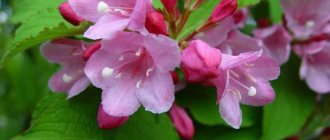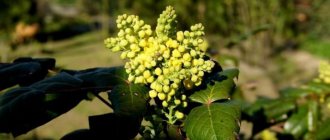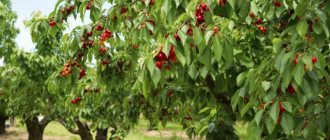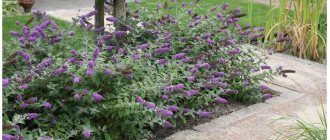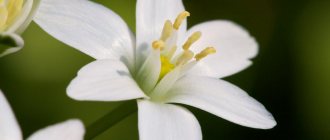Home » Landscape design » Lianas, Bushes and Trees
Vladimir 03/24/2020
23218 Views 1 comment
Beautiful and bright weigela flowers look very impressive in garden design and it is not surprising that this flowering shrub has won the hearts of many gardeners. Weigela, planting and caring for which is not complicated, but still requires some rules, can fit into any garden design because the flower has a wide variety of shades.
Botanical description of weigela shrub
Weigela is a deciduous shrub. The shoots are erect, their height is from 50 to 200 cm, but some varieties grow up to 3 meters. During growth it does not form stolons. The leaves grow according to the principle of opposite arrangement. The shape is slightly elongated, elliptical, the edges are slightly jagged. The stalk is small.
Depending on the type and growing conditions, the flowers can be single or collected in inflorescences of 2-6 buds. The color can be different: white, pink, red, purple. Pedicels are moderately developed. Sometimes the calyxes grow together into a common peduncle. The flower itself has a slightly elongated shape and 5 petals. Outwardly very similar to a bell. There are also five stamens and they are smaller in size than the corolla.
After flowering, a hard box is formed on the bushes, which has a cylindrical or oval shape. Inside it, small angular-shaped seeds with winged parts ripen.
Why doesn't weigela bloom?
Proper care of weigela guarantees abundant flowering of the shrub. If only a few buds appear on the plant or there are none at all, it is worth reconsidering the conditions for its cultivation. The main reason for the lack of flowering in weigela is excessive pruning. Inflorescences form on branches that grew last year and this year. If you cut out active shoots, there will be no flowering.
The formation of buds and the growth of weigela are influenced by its location. If you place a shrub near trees that actively absorb nutrients from the soil and water, flowering may not occur. Weigela requires sufficient soil moisture and the presence of nutrients in it.
Flowering shrubs need sunlight and warmth. Weigela will not bloom in the shade of other plants and buildings.
On a note! If all growing conditions are met, but the shrub does not bloom, the problem is that the plant is damaged by disease or pests.
Features of weigela flowering
Weigela is loved by gardeners not only for its compactness and decorativeness, but also for the opportunity to enjoy its flowering twice a season.
The first period falls at the end of spring and beginning of summer. Under favorable conditions, flowering repeats in early September. True, there are not as many inflorescences as in summer. The buds that appear on the bushes initially have a very pale color. But in the process of blooming, the flower begins to become saturated with colors and, as a result, the color becomes bright.
The aroma is weakly expressed, it is unlikely that it can be detected in the garden, but it is quite enough for pollinating insects.
Currently, there is a wide selection of weigel colors: you can choose a bush with pink, white, yellow, red, cream and even speckled flowers.
Appearance and features
The shrub has a well-developed branch structure with vertically standing woody shoots. The foliage is abundant and deep green. The leaves are lanceolate, with a red or light brown central vein.
The flowers are bell-shaped, approximately 3-5 cm in diameter. The color varies from pale milky, almost white, to bright yellow with an orange center. Small fruits ripen in a miniature box and have “wings”.
Winter-hardy weigela varieties for the Moscow region and beyond
Thanks to the efforts of breeders, it was possible to develop varieties of weigel that winter well in the central zone of our country. Let us consider below those species and their varieties that can be used for cultivation in the Moscow region and other regions.
Please note that the flowering weigela varieties Alba, Nana Purpurea and Nana Variegata are excellent for Siberia and the Urals.
Alba
Nana Purpurea
Nana Variegata
Flowering weigela or Florida (Weigela florida) + 19 varieties with photos and descriptions
Grows up to 3 meters. The shoots in two rows are covered with small hairs, and the leaf blade has pubescence along the central vein. Flowering begins at the end of May and lasts no more than three weeks. At this time, the bush is covered with pink flowers, collected in inflorescences of 3-4 pieces.
This species is represented by several varieties, consider them in the table:
| Variety | Characteristic |
| Rosea | Large bush up to 2 m high and 2.5 m wide. The flowers are large, pink, with a spicate limb, slightly dazzled with white. The leaves are light green, turning red in autumn. Blooms in June. The variety has excellent winter hardiness. |
| Candida | The bush grows up to 2-2.5 m. The flowers are large, white, collected in loose panicles. The leaves are light green. |
| Purple, red or Nana Purpurea (Nana Purpurea) | The height of the bush is 1.5 m. The crown is lush. Flowering begins no earlier than mid-June and continues until July. The flowers are an intense dark pink and the leaves have a reddish tint. Perfect if you don't have much space in the garden. |
| Alba | A low-growing bush about 50 cm in height. It blooms with white flowers that turn pink when withered. |
| Nana Variegata | It is considered the most frost-resistant weigela. Height up to 1.5 m. Leaf blades are small, green with a cream edging. The flowers are very beautiful, bell-shaped, white and pink. Blooms in June and July. |
| Pink Poppet | Dwarf bush, spherical crown. Height 0.8 m. Leaves are oblong, pointed, jagged, pleasant green in color. The flowers are soft pink. |
| Pink (Bunge) | The variety is distinguished by large pink bell flowers (4 cm in diameter). The height of the bush is 1.5 m, the crown is spreading and lush. |
| Victoria | The height of the bush does not exceed 1 meter, the leaf blades have a brownish-red tint, and the flowers are purple-red, light pink inside. |
| Alexandra | The bush grows up to 2 m. The leaves have a unique purple color and the flowers are deep pink. |
| Marjorie | Height 1.2 m. The variety is distinguished by the fact that one inflorescence can simultaneously contain flowers of white, pink and purple colors. The diameter of the flowers is 2-6 cm. It blooms in May-June. The leaves are green, drop-shaped. |
| Brigela or Brigella | The bush grows up to 2.5 meters, the shoots hang down slightly. The leaves are light green with yellowish veins. The color of the flowers is ruby. |
| Ebony and Ivory | An ornamental shrub, the height of which does not exceed 0.9 m, width - 0.9-1.2 m. The leaves have a dark purple tint and will appear black from a distance. They are especially effectively set off by the snow-white inflorescences that appear at the beginning of summer. Frost resistance down to -29 ºС. |
| Black and White or Black and White (Black and White) | A dwarf bush with a rounded crown, 0.3-0.4 m high and 0.6-0.8 m wide. The flowers are white with a carmine-red throat, bell-shaped, there are many of them. The variety blooms in June. The leaves are initially dark green and gradually become plum-purple. They contrast beautifully with the flowers. |
| Carnaval | Plant height up to 0.7 m. Flowers are white, pink and red (on one bush). Flowering occurs in June-July. |
| Naomi Campbell | Compact shrub with a dense crown up to 0.9 m high. The flowers are purple-red, the leaves are dark purple-bronze. |
| Pink Princess or Pink Princess | The height of the variety is 1.5 m. The crown is spreading. The flowers are a pleasant light pink shade. Blooms in May-June. Sometimes it blooms again in August. |
| Ruby Queen | Height up to 0.8 m. The crown is very dense and branched. The leaves are reddish or copper in early summer, gradually becoming brownish-red, but without the purple tint. In hot weather they change partly to a dark olive green color, but at the tops of the shoots new leaves still grow brownish-red. In autumn they turn shades of bronze. Bell flowers appear in June. They are dark pink in color and become darker as they bloom. |
| Wings of Fire or Wings of Fire | The height, as a rule, does not exceed 0.9 m. But by 10 years it can reach 1.2 m. The leaves in the spring are green-brown with a reddish or copper tint, in the summer they become light green, and from July they again begin to acquire purple-red shades . The flowers are pink-lilac. Flowering occurs in June-July. |
| Elvira or Elvera | The height of the bush is up to 0.9 m. The crown is dense and compact. The leaves are dark purple. The flowers are pink. The variety begins to bloom in June, but may repeat in August-September. |
Hybrid weigela (Weigela hybrida) + 3 varieties with photos and descriptions
Grows up to 1.5 meters in height. The crown is spreading. The flowering is abundant and lush, the color of the petals depends on the variety. The following varieties belong to hybrid weigela; we will also consider them in the table:
| Variety | Characteristic |
| Bristol Ruby | The variety was bred in the USA. A tall shrub that grows up to 2-3 meters. The crown is very lush. The leaf blades are bright green. Flowering begins in May or June, the petals are red with ruby edges, and there are buds with an orange core. Inflorescences abundantly cover the shoots. This variety can be used as a hedge, as the centerpiece of a flower bed, or as a colorful backdrop. Even with the arrival of autumn, the shrub retains its beautiful green foliage for a long time. |
| Red or Red Prince | Another American variety. It grows up to 1.5 meters, the shoots droop slightly, the crown is lush, the flowers are bright red. The leaves are green and beautiful. The variety can bloom twice per season (in May and August). The leaves do not fall until late autumn. Withstands frosts down to -20 °C. |
| Eva Rathke | A hybrid between Korean weigela (coraeensis) and abundantly flowering (floribunda). The bush is compact, up to 1.5 m high with a spreading crown (its diameter is up to 3 m). The leaves are light green. The bell flowers are 4 cm in diameter, blood red on the outside and lighter on the inside. Blooms in June-August. |
Early weigela (Weigela praecox) + 3 photos
This species is most often found in natural conditions in the Far East. The height of the shoots can reach 2 meters. The upper part of the leaf blade is covered with fine fluff and yellow specks, which turn creamy in the sun. Inflorescences are formed on the lateral shoots of the current year and consist of 2-3 flowers. Their color is often pink, but sometimes the throat can have a light yellow tint.
The buds begin to bloom in the last week of May, flowering lasts from 1 to 4 weeks.
Weigela suavis + 3 photos
It is a shrub up to 1.5 m high. The leaves are green, bare, pointed, pubescent on the inside, up to 6 cm long. The flowers are pink-violet or lilac-pink, pale pink inside. The species blooms from late May to June, sometimes longer. Possible re-blooming at the end of August.
Variegated weigela (Weigela variegata) + 3 photos
Bush 1.5 m tall. The flowers are pink-red, grow singly or in groups of up to 2-6 pieces. The leaves are green with white edges. It blooms in May-July, sometimes it blooms again at the end of summer.
Weigela middendorffiana + 3 photos
The height is 1-1.5 m, the shoots are erect and ascending. The flowers are large, bright yellow, 3.5-4 cm in diameter. They can be solitary, but most often they are collected in an inflorescence of 3-4 pieces. Under favorable conditions, flowering occurs twice per season. The leaves are large, light green, finely toothed, oval with a pointed tip.
New winter-hardy weigela varieties for central Russia
Breeders are constantly working on new varieties of weigela that can be grown in areas with frosty winters. For example, such new products are:
- Variety All Summer Peach. This is the most compact of all varieties of flowering weigela. It grows no more than 40 cm in length and width. The leaves are bright green, flowering occurs in May-June with peach-white tubular inflorescences. It re-blooms in August-September and is a winter-hardy variety.
- The Caricature variety, also low-growing, is intended for green borders. It has very unusual twisted thick and large leaves, similar in shape to basil leaves, with a light edging. Pink flowers appear in May-June, August-September. Winter-hardy.
Where can we grow weigela?
The main advantage of weigela over other ornamental shrubs is its resistance to frost and adverse weather conditions. In nature, it is widespread in Asia and the Far East, but some types of this plant can be grown throughout Russia.
The most popular in garden design is considered to be flowering weigela, which can be planted in the middle zone, in the south of the country, in the Far East and in the south of Siberia. At the same time, Weigela Middendorf can also grow in Siberia, and in the Urals, in addition to this variety, Weigela Maksimovich can also grow.
For the central part of Russia, early and garden weigela are suitable, and hybrid weigela can be grown with equal success in all regions.
Planting weigela in spring in stages
A shrub with Asian roots has long been adapted to our growing conditions, so when planting weigela it is enough to adhere to simple agrotechnical rules.
Choosing a weigela seedling
The most important step when growing weigela is to choose the right healthy and viable seedling. Today you can buy it almost anywhere – from famous nurseries to little-known online stores. Of course, it is better to buy a plant from trusted manufacturers and do it “live” in order to independently assess the condition of the bush.
When choosing, you need to pay attention to the following parameters:
- Weigela should be approximately 3 years old. If it is much smaller, it will be difficult for the plant to adapt to new conditions. But an adult weigela may not like the transplant, because she is already accustomed to her living conditions and may simply not tolerate stress.
- The root system must be closed if you plan to plant some time after purchase. If the roots are open, then the weigela will not be able to stand for a long time without soil and water. In this case, you need to prepare the bed in advance and immediately place the bush with an open root system in the ground from the nursery.
- It is worth choosing plants with healthy roots without signs of pests or damage. If you purchase seedlings with an open root system, slight drying of the roots is allowed. To prevent them from completely drying out, for example, during transportation, they are first placed in a clay mash, taken out and waited for drying.
- The shoots should not be wilted; there should be no signs of damage, cuts or lesions on their surface.
Choosing a place to plant weigela
Weigela grows well in both sun and shade. But it is worth considering that she still prefers sunny places and the brightest and most luxuriant flowering can be obtained only with a sufficient amount of light. Otherwise, the color of the leaves and petals will be pale and the crown less lush.
It is best to plant weigela in a well-lit part of the garden, protected from wind and drafts by a fence or nearby plantings.
You should not place weigela in lowlands where water drains poorly or accumulates after snow melts. If there is stagnation of moisture at the roots, there is a risk of developing various putrefactive diseases.
The best soil for weigela
Weigela grows well in loamy or super-sandy soil. It must contain humus and a little sand. In addition, when planting shrubs, it is necessary to consider a drainage system that will avoid stagnation of moisture at the roots of the plants.
Soil acidity can be neutral or slightly elevated.
Weigela planting dates
In the regions of the Central zone, you should not risk planting weigela in the fall. She will not be able to survive the winter and will die.
The best period for planting shrubs is April - early May. In the southern regions, you can start work a few weeks earlier. The main thing is that the earth warms up to +13 °C, and that night frosts do not appear in the weather forecast for the coming days. Seedlings with a closed root system can be planted at any stage of growth and even during the flowering period.
It is better to work with young seedlings before the buds swell on them.
Step-by-step instructions for planting weigela
The instructions for planting weigela are quite simple. It includes several stages:
- Soil treatment . It is advisable to pre-fertilize the place where the shrub is planted. It is better in the fall, digging up the ground along with manure, humus and compost. If this has not been done, then immediately before planting it is necessary to add organic matter and mineral fertilizers.
- Preparing the hole . The hole dug should be twice as large as the size of the rhizome with a lump of earth. The bottom of the hole must be covered with gravel or expanded clay, which will act as a drainage cushion. But if the soil is quite loose and light, then this stage can be skipped.
- Inspection and preparation of seedlings . Purchased seedlings should be carefully inspected for damage to the roots and signs of the presence of insect pests. If there are dry or rotten roots, they must be removed before planting. If weigela grows in a pot, then before placing it in the garden bed, it must be thoroughly watered. Seedlings with a closed root system are immersed in water for 4-6 hours so that the lump is saturated with water. If plants with an open root system were treated with a clay mash, then before planting all the clay from the roots must be washed off - it inhibits the normal growth and development of the plantings. Weigela takes root well and adapts to a new place without additional tricks, but if the purchased seedling causes you concern, then you can soak the roots in a special solution with the addition of a growth stimulant, for example, Kornevin.
- Landing distance . If you do not plan to make weigela part of the landscape composition, then it is recommended to plant it no closer than 2 meters from your neighbors. When creating a hedge, the distance between seedlings should be 1-1.5 m.
- Watering and mulching . The seedling is carefully placed in the hole. If the roots are open, they need to be straightened inside the hole. Next, it is covered with soil and watered. To retain water inside the soil, it is necessary to mulch the top layer of soil around the bush. For these purposes, you can take sawdust or bark.
How to plant a plant correctly
Proper planting and care of shrubs
In order for your plant to delight you with its beauty for many years and give an abundance of magical flowers, it is very important to approach the issue of planting responsibly. It is necessary to choose the time and the most suitable place for the bush.
It is optimal to plant in the spring, when the soil is just beginning to warm up and the buds have not yet swelled; it is at this time that the shrub has the best survival rate.
Weigela bush in the garden
Autumn is not the best time for planting, as the bush does not have time to adapt and the very first frosts can lead to the death of the plant.
It is important to choose the right place for planting. It is best to give it if it is a place on a slight elevation, which will not be exposed to winds from the north side and will be protected from drafts. Drafts can be dangerous for buds and flowers - they can simply fall off. The best location for weigela is the south side.
It is correct to place the shrub in a well-lit area, since light is necessary for flowering and an abundant number of buds. The soil should be saturated with humus and have a loose structure.
It is recommended to plant seedlings that have reached three years of age.
Planting in open ground
Planting shrubs
Consists of several stages:
The first thing is to choose the right place to plant the seedling. The place should be moderately sunny or in slight partial shade. You should not choose places that are too shaded; this plant does not like shade.
If there is an edging on the leaves, then such a seedling should be planted only in a sunny place, since this is a light-loving variety.
Particular attention should be paid to protection from wind and drafts. A fence, building or other shrubbery can be used as protection. If there is no protection, then gusts of wind will tear off the flowers.
After choosing a location, we proceed directly to planting seedlings. To do this, dig a hole about fifty centimeters deep; if the soil is fertile, then intensive feeding is not required and the depth can be reduced to forty centimeters. The dimensions of the pit should be 50 by 50 cm.
If you are planting more than one seedling, then it is worth ensuring that there is at least eighty centimeters between them for a low-growing variety and at least two meters for a tall variety. It is advisable to remove weeds and their roots from the site as much as possible.
The bottom of the dug hole should be filled with drainage; for this, a layer of sand and gravel is used. The optimal height of the drainage layer is not approximately fifteen centimeters.
The seedling is placed in a hole and carefully covered with the prepared mixture: two parts sand, two parts leaf soil or humus, one part turf soil. If the soil in your garden is not highly fertile, then compost is added to the mixture, approximately fifteen liters per bush, and one hundred grams of nitrophoska.
The shrub is actively used in landscape design
Do not over-compact the soil; the roots feel more comfortable in slightly loose soil. It is important that the root collar is clearly level with the ground.
If a container was used to grow the seedling, then freeing the root system from the soil is not required; planting should be done immediately with a lump. After which you need to provide abundant watering. Next you need to mulch along the root circle.
If you know that the survival rate of the seedling is at risk, then the plant is first treated with special agents that stimulate growth.
Weigela care
Weigela is quite unpretentious in care; it requires compliance with simple agrotechnical rules.
Watering
Plants sitting in pots (when grown indoors, for example) need frequent watering because the soil dries out much faster in a confined space. In open ground, weigela should be watered as the soil dries out. It is enough to pour 2-4 buckets of pre-settled water under each bush.
To retain moisture in the garden bed, it is advisable to mulch it. This can be sawdust, bark or fallen leaves, pre-treated with a disinfecting solution.
How to feed weigela
Weigels, like many other flowering plants, need sufficient nutrients to help new buds form. Initially, seedlings need to be planted in pre-prepared soil, diluted with organic matter and humus. To stimulate flowering in mid-May, you can apply complex fertilizers that contain potassium and nitrogen.
Loosening
Weigela roots are quite sensitive, so the loosening procedure must be carried out extremely carefully. The space around the trunk circle is processed to a depth of approximately 10-15 cm. It is not necessary to repeat the procedure often; in order to improve aeration and fluid permeability, it is recommended to mulch the bed.
Transfer
It is possible to replant weigela, but this procedure is quite complicated and painstaking. Sometimes the bush begins to interfere with the redevelopment of the site, or it was initially planted in an excessively shaded place, where flowering is reduced to a minimum. In this case, it is allowed to move the plant. This is done in the first weeks of April, the weigela is transferred along with a lump of earth to a new place. But you need to remember that this is a huge stress for the plant, so replanting should only be done in extreme cases.
Preparing weigela for winter
Mature plants that have been growing on the site for more than one year do not need special shelter, especially if frosts in winter do not drop below +25...+28 °C. But newly planted or transplanted shrubs must be insulated in the first years. Construction of the shelter begins with the onset of the first frost.
First of all, the branches are wrapped in burlap and carefully fixed to the surface of the ground. If this is not done, they may break under the weight of the snow cover. Spruce branches or straw are laid on top, the entire perimeter of the bush is covered with a special material, the edges of which at the bottom are pressed to the ground with bars or bricks. You can build a wooden frame or place arches over the bushes, then the covering material will go along the top of the structure.
Plant propagation methods
Weigela is propagated in several ways:
- propagation by seeds
- propagation by layering
- vegetative propagation
Propagation by seeds
The predominant majority of weigels that can be found in our regions are hybrid varieties. They differ from their wild brothers in a larger color palette, their flowers are larger, and the color of the leaves is more saturated; the color of the leaves is often purple.
The disadvantages of this method of propagation include the fact that it is not able to convey all the characteristics of the variety of the propagated plant.
Plant seeds
But for propagation by seeds there are several rules. The first thing that is important to remember is that the seeds have a short shelf life and after a year they already lose their viability. The seeds must be sown in the spring in special pots in which a special mixture is placed: two parts soil and one part sand. A small layer of sand is poured directly.
Next, the crops must be covered with transparent glass and placed in a warm place. It is important to periodically ventilate the pot with seeds and carefully water it, and it is best to use a spray bottle to spray the surface of the soil for watering. After three weeks, the first shoots will become noticeable.
When two leaves form on the seedlings, you can place them in separate pots. In new containers, maintain high humidity, keep the plant under film until it begins to grow.
It is also known that weigela can be propagated by self-sowing, but in this case it is practically impossible to plant a young seedling. This is due to the fact that self-seeding is possible already in adult plants, which require less careful care; compacted soil is suitable for them, unlike young plants. When trying to plant a young seedling from dense soil, the weak roots are injured or even break off and the plant does not survive.
Reproduction by layering
Reproduction in this way is carried out in the spring. To do this, take a twig that is located close to the ground. It is bent a little and a small cut is made in the wood. The resulting cut must be treated with a special prepared mixture of root and activated carbon powder.
Scheme for obtaining cuttings from a plant
Next, a match is inserted and dug in so that the resulting cut is placed in the ground. To secure the layering, you can use pins or small metal arcs. In the fall or next spring, the new plant must be cut off from the mother plant and planted in the place chosen for it.
Vegetative propagation
The best of all the options considered is considered to be vegetative propagation , namely propagation using cuttings. If your goal is to produce a large number of young shoots, then the first thing to do is to choose a strong and healthy plant with abundant flowering, which will act as a mother bush. Its main purpose is to bring the maximum number of healthy and strong cuttings.
Initially, it is necessary to get rid of all obviously weak shoots; they need to be cut off at the root . Strong shoots also need to be trimmed, but only to half. Trim as many branches as you need new plants. Shoots that grow back after pruning are much more capable of forming new roots than a plant that is not pruned.
During the cutting process, the upper part of the shoot is cut off only if it has failed to ripen. The length of the cuttings is ten to fifteen centimeters.
Rooted cuttings planted in open ground
The oblique cut at the bottom should be half a centimeter below the bud; all lower leaves are cut off and specially treated with a stimulating drug.
To root a large number of cuttings, it is convenient to use a cold greenhouse, and if you need several cuttings, then an ordinary pot is suitable , in which drainage is poured into the bottom and covered with soil on top, and then covered with three centimeters of sand.
After this, holes are made in the soil with a special wooden stick and the prepared cuttings are planted in them, deepening each by four centimeters. After planting, the plant is watered with fungicide, the pot is covered with film and placed in a dark and warm place.
Subsequent care includes the correct watering regime and timely ventilation of the cuttings . With the arrival of spring, the shelter of the cuttings can be removed when the resulting shoots are noticed. Such cuttings can be planted after a year and a half. During this time, it is advisable to pinch the plant several times.
The process of propagating weigela using lignified cuttings is quite labor-intensive and it will be quite difficult for novice gardeners to achieve success on the first try.
How to propagate weigela
There are several methods of propagation for weigela. All of them are given below.
Seeds
When the flowers fall, seed pods form in their place. At the end of autumn, you can collect seeds and start growing weigela. To do this, take special containers filled with soil mixture. Seeds are sown in them in the usual way. Watering is carried out from a spray bottle. The seedlings can be thinned out and as many sprouts left as needed. If the work was carried out before winter, then in May young plants can be planted in open ground.
Cuttings
For cuttings in November, it is necessary to prepare cuttings, which should be stored in a cool but well-ventilated place in winter. The height of the cutting is 25-30 cm. The upper cut is made a millimeter above the last bud, and the lower cut is made below the last bud. It is advisable to make the latter beveled - this will increase the surface area through which rooting will take place. The cutting should also be placed in the ground at a slight slope. At least 4 buds should remain above the surface of the earth. The root system develops in the second or third week from the day of planting.
By layering
This method of propagating weigela is highly effective, since rooting occurs under natural conditions. To do this, the strongest lower shoots of the bush are selected, which grow almost at the base of the ground. Several cuts are made on them up to the leaf node. You should only use a very sharp and well-sanitized knife. The cut areas are treated with any suitable growth stimulant, after which the shoot is pressed to the bed with a thick wire bracket and lightly sprinkled with soil mixture. For greater efficiency, you can additionally cover the rooting site with a layer of mulch. The first roots will appear in a couple of months, but cuttings can only be separated from the main bush for the next season. Transplantation is carried out only after three years, but flowering can only be expected in the fifth or sixth year.
Dividing the bush
The method is used when it is necessary to rejuvenate the plantings or change the habitat of the weigela on the site. The bush is dug out of the ground, the roots are washed from adhering soil. Next, using a sharp pruner, parts of the bush are separated along with the roots. The cut areas must be powdered with crushed coal. After this, the entire ground part is cut off, and the bushes are planted in a new place. The procedure can only be carried out during the weigela dormant period, which begins in October and lasts until April. To divide, the adult plant must be at least 4 years old.
Weigela pruning
The crown of weigela is quite lush, it tolerates shaping well, thanks to which you can give the plant any shape.
- To stimulate the growth of new shoots, it is necessary to trim 2-3 secondary shoots at the base of the bush. To do this, use a well-sharpened pruner; you need to cut the branches at an angle of 45 degrees as close to the ground as possible.
- For lush flowering, always trim off the achenes that appear in place of fallen flowers. This way you will allow the plant to save energy and spend it not on forming seeds, but on developing new buds.
- Always prune diseased or dead branches to prevent them from killing the main shoots. They need to be cut at an angle of 45 degrees as close to the main stem as possible.
- Sometimes branches appear on the weigel that look very weak or rub against the main stem and risk damaging it. They should also be trimmed at the base.
- To rejuvenate the planting over three seasons, shorten the branches by a third each time. This will help the plant restart its development program and produce new shoots.
Tips for pruning weigela
- Pruning work is best done in late autumn or early spring. If you want to maximize the abundance of flowers, trim the branches before the bush blooms.
- After the second half of July, it is strictly not recommended to touch weigela.
- The maximum permissible pruning length per season is one third of the shoot.
- To maintain the decorative shape of the bush, prune annually.
- Always use only sharp and disinfected tools.
- Formation is carried out only under the bud pointing upward, so that the new shoot does not begin to grow towards the bottom.
Weigela responds very gratefully to formative pruning, which allows her to create unusual shapes for the original design of her garden plot.
Weigela after flowering
How and when to collect seeds
Weigela seeds ripen in September, and they need to be collected in November, when the boxes begin to crack. To prevent the contents of the boxes from spilling into the soil, wrap several seeds in gauze in September and secure it on a branch, and in November, cut off the box along with the gauze, bring it indoors, carefully remove the gauze, shake out the seeds on a newspaper, dry them, pour them into a paper bag, write on it the name of the plant, variety, planting date and store it in a dry, dark place until spring. Remember that weigela seeds lose germination after a year or two, and plants grown from seeds rarely retain the varietal characteristics of their parents.
Wintering weigela
When all the leaves fall from the weigela, and this will happen at the end of October or early November, sprinkle the weigela circle with earth, forming a hill 15-20 cm high. It is better to bend the weigela branches to the ground and press them to it, as is done with hydrangea, and Cover the top with roofing felt or spunbond, securing the coating so that it does not blow off the wind. You can not bend the branches to the ground, but tie the branches tightly with rope or twine, fence the bush with a frame made of metal or plastic mesh, pour dry leaves inside this structure for warmth, and wrap this structure on top with a thick covering material.
Weigela diseases and pests
Most often, weigela becomes prey for caterpillars and aphids. As a preventive measure, you can use infusions of garlic, red pepper or wormwood. They spray the plantings. But if the colony of pests is large-scale, then full-fledged treatment will be needed; Keltan, Nitrafen or Rogor will help get rid of them. They must be used with extreme caution due to the toxicity of the components.
The leaves may turn yellow due to the larvae of cockchafers or mole crickets; they destroy the roots of the plantings. Treatment of the soil with a solution of Karbofos or Aktara will help to cope with them.
A solution of Bordeaux mixture will help overcome gray rot, rust, and spotting. If signs of disease have already appeared on the bush, then spraying with Topsin is carried out.
Top dressing
The plant is fed three times per season. The first time the plant is fertilized before the active growing season begins. A nitrogen-containing compound is added to increase green mass.
The second time the bush is fertilized with potassium-phosphorus additives to stimulate bud setting. As a rule, this occurs between waves of flowering, in July. At the end of August, you can feed Middendorf's weigela with organic fertilizer.
Mr. Summer resident warns: problems when growing weigela and their solution
In spring, weigela grows poorly and does not gain vegetative mass. The reason for this may be the freezing of the plant in winter, which affects the decrease in activity. Treating with Epin and applying special fertilizers will help solve the problem. If even in mid-June the weigela has not turned green, then the plant can be uprooted - it is dead.
After transplantation, the plant withers and dries. This may occur due to stress and exposure to sunlight. Weigela must be covered to protect it from the sun for 2-3 weeks, until the adaptation period ends and the roots take root.
Description of the Middendorf variety
Middendorff's weigela (W.middendorffiana) is a deciduous shrub of the honeysuckle family. Typically, the size of this variety of weigela can exceed 1.5-2 m, although there are also miniature specimens whose height does not reach 70 cm.
The crown of the bush is proportional and has a spherical or ellipsoidal shape. The root system is mixed, located close to the surface. The plant adapts perfectly to any type of soil, but does not tolerate cold drafts.
It reacts to obvious violations of the rules of care by rapidly dropping leaves and buds.
Weigela in landscape design + 18 photos
Weigela can be used autonomously on a site; thanks to its beautiful flowering, it also looks harmonious when planted alone. The shoots lend themselves well to pruning, which allows you to form a crown of the desired shape.
Landscape design experts recommend using weigela in compositions as a smooth transition from grasses to trees.
The shrub is ideal for creating hedges. They can go along the edges of the paths, highlighting them against the background of the lawn, or beautifully zone the area. The height of the hedge can be easily adjusted by trimming.
Photo gallery of using weigela shrubs in landscape design (18 photos):
Design and garden
Weigela is a universal plant that can be planted in your garden as a hedge, part of a composition with jasmine, astilbe and other tall perennial plants, and as an independent specimen.
It is used to differentiate from plants in the garden; for example, low-growing varieties planted in a neat pot are perfect for this. Weigela also often serves as a “transitional” plant between low and tall ones and dilutes the overall picture with its bright inflorescences.
This is especially true for coniferous design solutions, where there are no bright colors as such - weigela in this case will be a breath of clean air.
Growing rules
Weigela Middendorf requires certain care conditions, especially in the first three years of growth, and then annually during flowering.
Watering
Adult Weigela Middendorf is calm about the lack of precipitation. Watering is carried out at the time of budding and further flowering, frequency – once every 6 days. For the second flowering, watering depends on precipitation. A large amount of moisture during autumn flowering can give a negative result; the flowers do not have time to fully open and begin to fall off. Young Middendorf seedlings are watered periodically with a small amount of water. The soil should be slightly moist.
Top dressing
The first feeding of weigels is carried out immediately after the snow melts. Complex fertilizers are scattered around the bush; urea or potassium salt will do. At the time of flower bud formation, weigela is given superphosphate. Before the second flowering, organic matter is added.
Loosening, mulching
After each watering of young seedlings, the root circle is loosened, and weeds are removed along the way. Loosening is carried out shallowly to raise the top layer by about 5 cm. Adult plants do not need loosening. Weeds must be removed; this measure prevents the spread of aphids.
Mulch Middendorf weigela immediately after planting. In the fall the layer is increased and in the spring it is renewed. It is recommended to use crushed tree bark as mulch. The material retains moisture well and looks aesthetically pleasing on the site.
Pruning, crown formation
Weigela Middendorf is compact, not spreading, has a natural decorative habit, so the shrub is often left in its original form. Sanitary pruning is carried out, dry areas and shoots that died over the winter are removed in the spring. Every three years the crop is rejuvenated by cutting out 3-4 old branches. Weigela Middendorf responds well to pruning shoots, holds its shape for a long time, and therefore is used by landscape designers.
Preparing for winter
Weigela Middendorf is characterized by increased winter hardiness. An adult plant after 6 years of growth does not require crown cover; abundant watering and a layer of mulch made of straw or pine needles will be sufficient. You can cover the root circle with spruce branches. Young bushes of the Middendorf variety need thorough wintering measures:
- The plant is spudded.
- Cover with a layer of mulch.
- The crown is collected into a loose bundle and carefully secured with a rope.
- I bend it to the ground, install arcs, and tighten the covering material.
The structure is covered with spruce branches on top, and a snowdrift is thrown over it in winter.
6.Application in gardening
Depending on the size of the variety, you can use weigela as a border plant or, by densely planting the bushes, to create a living flowering hedge for the garden. Early and abundant flowering will attract many beneficial insects to the garden. including bees.
In order to extend the flowering period, you can plant other flowering shrubs next to the weigela - lilac, jasmine, decorative hawthorn, spirea and others.
With proper care and selection of the right site, flowering weigela can compete with such generally accepted garden favorites as, for example, rhododendron. Even after complete flowering, weigela bushes will decorate the garden with their variegated leaves.
The combination with coniferous plants, such as cypress or juniper, looks great.
↑ Up,
